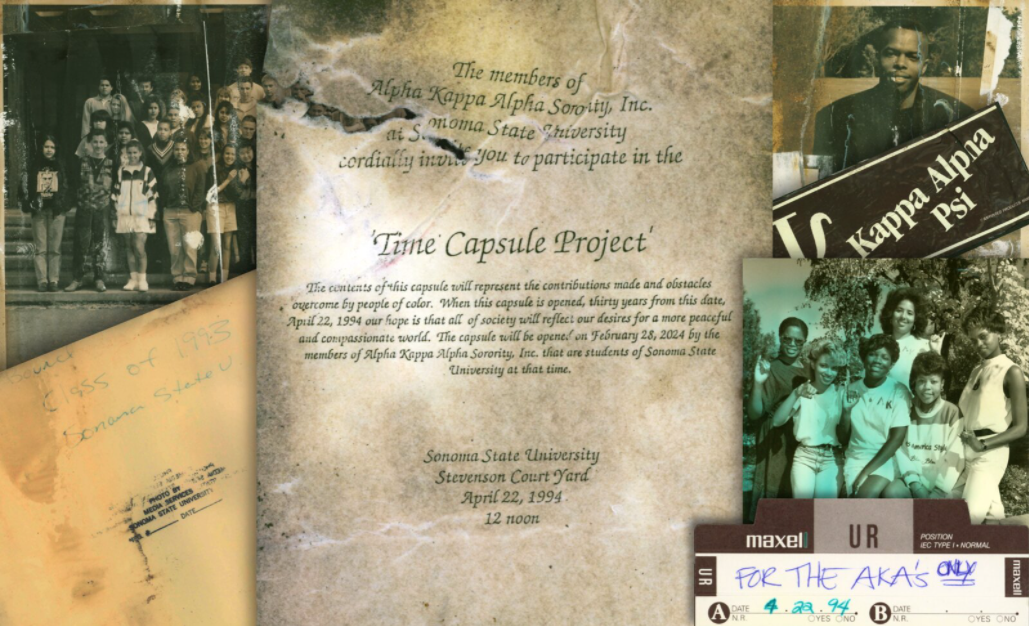COURTESY // SSU News
Truebeck construction workers uncovered a time capsule buried by an old Sonoma State sorority 27 years ago while working on the Stevenson renovation.
Almost 30 years ago, a sorority called Alpha Kappa Alpha, which no longer has a chapter at SSU, and other organizations on campus put their thoughts, aspirations and whatever else they could in a little blue box and buried it. They aimed to show what life was like for them as young people of color attending Sonoma State University in 1994.
They did not expect, however, that this little blue box would be pulled out of the mud only 2 years before its expected retrieval during the reconstruction of the Adlai Stevenson Building in April 2021.
“In April of 2021, construction site foreman Laszlo Vincze of Truebeck Construction and his excavation crew stumbled upon an unexpected find: a clear plastic box with a blue lid filled with deteriorating items, and considerable mud and water, buried in the Stevenson Hall courtyard. They’d found a time capsule,” stated Special Collections Librarian Lynn Prime and digitization specialist John Muller in their original article of the find. Vincze brought the box to the Sonoma State Library where Muller and Prime would digitize the contents.
“When I first heard that a time capsule had been found, I expected dusty relics and mementos from decades ago, but instead these were thoughtful and evocative chronicles of another time — and not so different from our own,” said Muller on the quality and contents of the capsule. Prime and Muller were mindful that the capsule’s uncovering did not happen at the hands of the alumni who buried it.
“It’s a sensitive topic, because I am sure the students of 1993-94 in the campus BIPOC community would have wanted to be the ones to uncover their own time capsule, as would have been right. Since the time capsule contents were inundated with water and mud, we digitized them and hope to get the word out about the materials to alumni so they can make plans for how and whether they’d like to fully reveal the (now digitized) contents and have a time capsule event in 2023-24, even if in a different context.” said Prime while reflecting on her role in cataloguing and uncovering the capsule.
Muller and Prime gave an overview of not only its uncovering but also a preview of the items and their authors: “Among the artifacts was a commencement speech application composed by Alpha Kappa Alpha member and organizer of the time capsule project, Sandra Jackson-Dumont, who is now director and CEO of the Lucas Museum of Narrative Art in Los Angeles.”
Jackson’s original commencement speech was intact as well, stating. “The purpose of this project is to sustain the history of students of color and their abundant contributions to the livelihood and cultural enrichment of Sonoma State University. This Time Capsule Project will inspire future students and will make them aware that people of color excel and succeed in spite of never-ending obstacles. It will be a temporary home for glimpses of the past and hopes for the future. Various organizations of color will be invited to contribute items to the capsule that represent today’s society and the role of the ethnic population in it. Also, there will be contributions that exhibit the effects society has had on people of color.”
The focus on social justice was present in almost every element put into the capsule. They not only focused on providing future students a look into the lives of students in 1994, but their advice and hopes for future generations as well.
M.E.Ch.A, Movimiento Estudiantil Chicanx de Aztlán, is a nationwide society of Chicanx students with a chapter on campus based in helping students find their roots and achieve academic success and political consciousness. M.E.Ch.A included a 47 page document with their hopes and mission statement in the time capsule.
“In hope that the MEChistas of this and other campuses have something on paper to refer to in time of guidance. We have a responsibility to ourselves (staying in school and graduating!), our Tierras (Aztlan), our culture, and to our future Raza — our children. We must educate all Raza about our her/history and the contributions our people have made in this continent, our continent. For we are its descendants and the result of its story.”
M.E.Ch.A’s current mission statement, as posted on their website seen by colleges and universities nationwide, is to “become a leader, connect and learn about your Chicanx identity, be involved in your community, become socially/politically conscious.”
The website also included this statement from the Santa Barbara chapter: “MEChA must bring to the mind of every young Chicanx that the liberation of their people from prejudice and oppression is in their hands and this responsibility is greater than personal achievement and more meaningful than degrees, especially if they are earned at the expense of their identity and cultural integrity. MEChA, is more than a name; it is a spirit of unity, a family, and a resolve to undertake a struggle for liberation in society where justice is but a word. MEChA is a means to an end.”
The organizations and students of 1993-1994 that contributed to the recently uncovered time capsule were focused on social justice and hope for a new generation of Sonoma State students. This piece of SSU History is accessible at the library by emailing [email protected].
Lynn Prime encourages students “to look at the contents of our fledgling Student Voices campus community archive and consider lending their experiences and voices to the project as a way to engage with what and how today’s students view their campus and community world.”





![[Both photos courtesy of sonoma.edu]
Ming-Ting Mike Lee stepped in as the new SSU president following Sakakis resignation in July 2022](https://sonomastatestar.com/wp-content/uploads/2024/04/CC4520AB-22A7-41B2-9F6F-2A2D5F76A28C-1200x1200.jpeg)


























